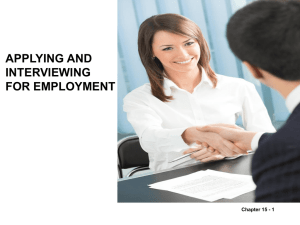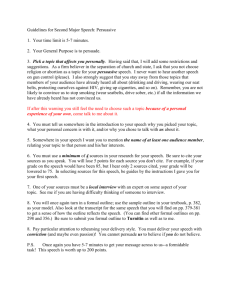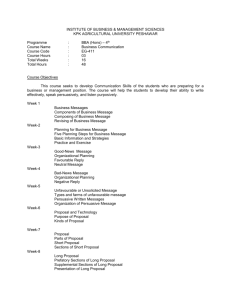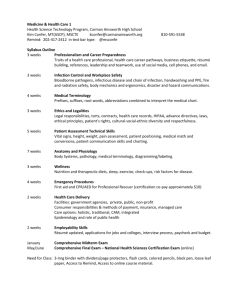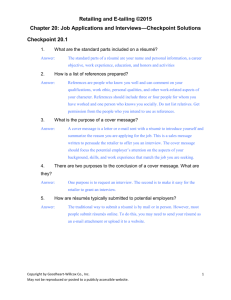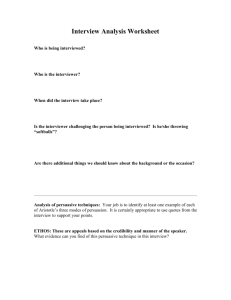VU Lecture # 32
advertisement
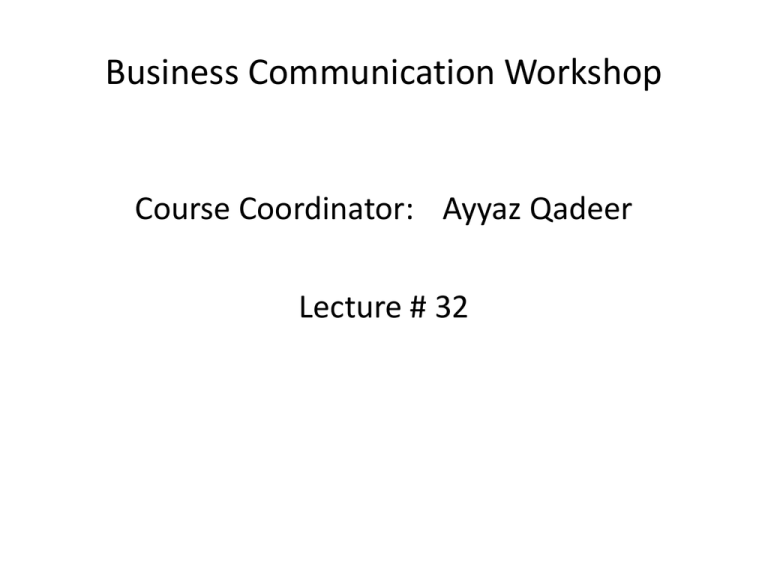
Business Communication Workshop Course Coordinator: Ayyaz Qadeer Lecture # 32 General Overview of Business Communication Workshop Bad-News Messages • We have discussed how to resolve Business Problems • The Three-Step writing process • Strategies for Bad-News Messages: When delivering bad news, you have five main goals • How to create an Effective Audience-Centered Tone • Indirect (Inductive) Organizational Plan: Bad News Plan Bad-News Messages • If you know your audience can handle bad news first, use the direct approach • Buffer statements: Possible Buffers for opening BadNews Messages • Evaluation of Buffer statements: Possible issues in writing Buffer in the opening paragraph • Characteristics of good Refusal Messages • Techniques for deemphasizing Bad News Bad-News Messages • How to use effective expressions in delivering Bad News Messages: Passive Voice • Ending Bad-News Message: Limit future correspondence on the matter. Keep it positive Be optimistic about the future and don’t anticipate problems. Be sincere. Be confident Types of Routine Bad-News Message Refusing information Refusing invitations and other requests Giving bad news about orders Refusing claims and requests for adjustments Bad-News Messages • • • • Refusing Claims and Requests for Adjustments Sending Negative Employment Messages Writing Plan for Refusing Requests or Claims Writing Plan for Announcing Bad News to Customers and Employees • Guidelines: Negative Performance Reviews Persuasive Messages • How do emotional appeals differ from logical appeals? • What is the AIDA plan, and how does it apply to persuasive messages? • What are four common mistakes to avoid when developing a persuasive message to overcome resistance? • What are some questions to ask when gauging the audience’s needs during the planning of a persuasive message? • What role do demographics and psychographics play in audience analysis during the planning of a persuasive message? Persuasive Messages • What are four ways you can build credibility with an audience when planning a persuasive message? • What three types of reasoning can you use in logical appeals? • How do benefits differ from features? • What are the key features of writing Plan for a Persuasive Request? • What are points to consider while writing effective persuasive complaints?: Persuasive Messages • • • • • • • • Ineffective Persuasive Request Letter Improved Persuasive Request Letter Good and bad openings for persuasive requests Ineffective Favor Request improved Favor Request Writing Plan for a Sales Letter Ineffective Sales Letter Checklist for Analyzing a Sales Letter Résumé and Cover Letter • French Word resume meaning “to summarize” • Common Résumé Problems • Some considerations before starting résumé • Writing a Persuasive Résumé • The major sections of a traditional résumé. Heading and Objective – List your name, address, phone. – Include a career objective for a targeted job. • Education Résumé and Cover Letter • Work Experience –Describe your experience. • Special Skills, Achievements, Awards –Show that you are well-rounded Poor Résumé Improved Résumé Résumé and Cover Letter • How to Prepare a Computer-Friendly Résumé • What Turns Recruiters Off When Reading a Résumé? • What Turns Recruiters Off When Reading a Résumé? • What Do Recruiters Consider Most Important in a Résumé? • What Is a Cover Letter? • Solicited Application Letters • Unsolicited Application Letters Résumé and Cover Letter • The use of language in Resume and cover leter. • Writing a persuasive job application letter Informal Report Writing • The Purpose of Reports: To make sound decisions, To provide a formal, verifiable link between people, places, and times; To solve immediate problems; To provide complete, accurate, objective information • Reports are commonly classified by some factors • Six Categories of Informal Reports: Information Reports, Progress Reports, Justification/Recommendation Reports, Feasibility Reports, Minutes of Meetings, Summaries • Report Formats: Letter format Letterhead stationery. Useful for informal reports sent to outsiders. • Memo format Memo style. Useful for informal reports circulated within organizations. Informal Report Writing • Report Formats: Report format Plain paper, manuscript form. Useful for longer, more formal reports. Prepared forms Standardized forms. Useful for routine activities, such as expense reports. • • • • General Guidelines for Writing Reports Where to Gather Data for Reports Planning Business Reports Investigating and searching for required information Informal Report Writing • Organizing Report Data: Indirect Strategy Direct Strategy • • • • • • Making Effective Report Headings Being Objective in Writing Reports How to write Information Reports How to write Progress Reports How to write Justification/Recommendation Reports How to write Feasibility Reports Informal Report Writing • How to write Meeting Minutes • How to write Summaries • Ten keys to designing better documents Formal Report Writing • When is it appropriate to use tables, line charts, surface charts, and pie charts in a report? • What five principles apply to effective visuals for business reports? • What tools can you use to help readers follow the structure and flow of information in a long report? • What is the purpose of adding titles and legends to visual aids in reports? • How do writers use transitions in reports? Formal Report Writing • List the three tasks involved in completing reports, and briefly explain what is involved in revising them. • Explain the prefatory parts of a formal report • Describe four important functions of a formal report’s introduction, and identify the possible topics it might include. • List four questions to ask when proofing visual aids. • What elements would you consider in proofreading and getting feedback? Proposals • • • • What is a Proposal? Proposals: Types Things to remember Some common parts of Proposal: title page, table of contents, abstract, introduction, background, Benefits and feasibility of the proposed project, Method, procedure, theory, Schedule , qualification, costs, • Organization of Proposals • Format of Proposals Oral Presentation • Three-Step Process for Oral Presentations • Reasons for Giving a Speech • Preparing an Oral Presentation: Identify your purpose, Organize the introduction, Organize the body of your presentation, Organize the conclusion • Ways of delivering your message Oral Presentation • Types of Verbal Support • Nine Techniques for Getting your Audience’s Attention: • • • • • A Promise Drama Eye contact Movement A question A demonstration Samples, gimmicks Visuals Appeal to the audience’s self-interest Oral Presentation • Maintaining Rapport: Use imagery. – Analogy – Metaphor Simile • Send positive, nonverbal messages. • Stage Fright Symptoms • How to Overcome Stage Fright • Handling Questions Oral Presentation • Presentation Enhancers • Designing and Using Graphics: • Ensure visibility. • Enhance comprehension. • Practice using your visual aids. • Features of an electronic presentation • Designing electronic presentation • Eight serious presentation blunders Interviews and Follow Up Messages • • • • • • • Typical hiring sequence Types of interviews: What an employer looks for Preparing for an Interview Things to do for an interview Potential discriminatory topics Succeeding in a telephone screening interview Interviews and Follow Up Messages • Preparing for a Hiring/Placement Job Interview: investigate the target organization; study the job description; practice answers to typical interview questions; expect to explain problem areas on your résumé; build interviewing experience with less important jobs first • Sending positive nonverbal messages Interviews and Follow Up Messages • How does a structured interview differ from an openended interview and a situational interview? • What typically occurs during a stress interview? • Why do employers conduct preemployment testing? • Why are the questions you ask during an interview as important as the answers you give to the interviewer's questions? • What are the three stages of every interview, and which is the most important? Interviews and Follow Up Messages • How should you respond if an interviewer at a company where you want to work asks you a question that seems too personal or unethical? • What should you say in a thank-you message after an interview? • What is the purpose of sending a letter of inquiry after an interview? • What is the legal significance of a letter of acceptance? • What organization plan is appropriate for a letter of resignation, and why? Ethics in Business Communication • • • • • • • • • • Importance of Ethical Communication Stages In Ethical Development: Lawrence Kohlberg (1973) Individual Ethical Frameworks Cultural Issues in Ethical Behavior Corporate Social Responsibility (CRS) Ethically Based Communication Style Ethically Based Communication Strategies Possible Ethical Communication Conflict Ethics and Decision Models Dealing with Ethical Dilemmas End

